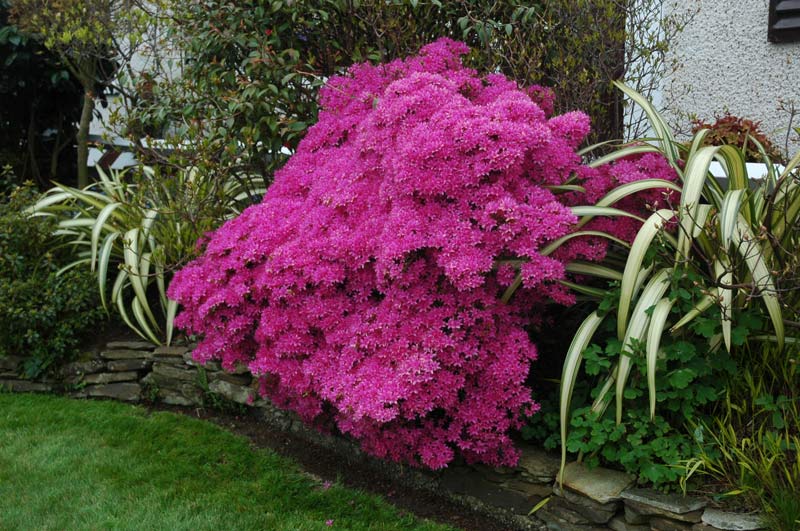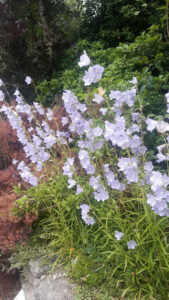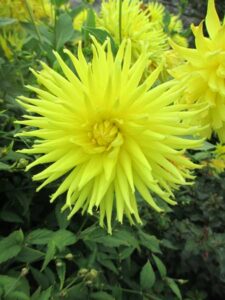Gardening
with Charlie Wilkins
THE GARDEN IN MAY
There’s simply no contest! The grandest and most beautiful month of the year has arrived and in these Covid stricken days, lucky those who have a garden to tend, a patch of ground to cultivate, even a window box or hanging basket to fill! The sound of occupation in the garden is now so welcome, for there is no joy in cocooning. The month of May deserves better, so why not consider some of its joys today? Let’s begin.
A shelf of gardening books is something like an attic of memories and forgotten stories! I wanted to look up ‘lilac trees’ now that we have entered May but could not find a single tome which could name a few modern varieties. My search was prompted by the arrival of the ‘May Gap’, a period between the spring bulbs-which have pretty much done their stuff by now- and the arrival of the herbaceous heavies. My favourite heavies include lupins, delphiniums, alstromeria, and early clematis, along with a Trinity of May delights namely columbine, peony and lily of the valley!
You do not have a May Gap? Then you are wise indeed and have planned for late cherries, wisteria, the golden rain tree (the American name for Laburnum) and wonderfully scented lilac. I commend and admire your wisdom and choices, but have you included those devotees of shadowy places: hybrid azaleas and choice rhododendrons? Perhaps not, so now is the ideal time to plan a change and to indulge in a tremendous gamble! You may embark with timidity on the purchase of these woodland gems (and watch over them with trepidation until they bloom) but be assured that they will bring rewards in abundance over many, many years.

There is something obsessive about these exotic shrubs! Gentlemen love them but the ladies are first to notice they’re muted pastel shades and powerful scent. Indeed, I have never met a gardener, male or female, who was disappointed with azaleas. Of course, if you love them and have the right kind of lime-free soil, the scope is joyous. Even if your soil is alkaline you can still grow them in suitable tubs and containers or in specially dug and prepared planting holes (separated from the surrounding soil by a vertical lining to the sides of the hole with polythene) in any half-shaded spot. Fill this hole with a lime-free medium; leaf-mould, pine-needles, garden compost or used potting compost.
I would like to tempt you with one or more Ghent azaleas which have fragrant long-tubed, honeysuckle-like flowers. No variety will be found less than good. The Knaphill and Exbury hybrids have a heavenly range of colours and the Mollis azaleas bloom early this month before their leaves appear. I still thrill at the sight of the soft rose-pink colours found on the likes of ‘Berryrose’ and the whites with just a touch of yellow such as ‘Persil’.
Surely you remember me mentioning this last variety on more than one occasion previously. In the twenty and more years it has stood in the front garden it had never failed to impress either in the perfection of its blooms or intense perfume. Nearby grow wide, fat, dumpling-shaped specimens of evergreen azalea ‘Vucky’s Scarlet’ (see illustration) ‘Blauw’s Pink’ and ‘Adianthum’ in sky blue. They need neither attention nor coddling from year’s start to finish and this includes my regime of absolutely no pruning. They just don’t need it, all being tidy, compact growers.
Feeding is done with leaf litter in autumn and every sweeping is used as mulch material around and beneath their branch network. If you want to give special attention to this aspect of their cultivation opt for rotted pine needles or shredded fronds of wild bracken. Both are free, they acidify the soil, add humus and conserve moisture.
Many of the above and a host more are in flower now should be in garden centres if they were open.. Source and plant them as soon as this miserable period is ended. They will not be in flower then, but they’ll be your star attraction this time next year.
THE GARDEN, MAY 2020
CUCKOO: This is the weather the cuckoo likes, and so do I, but the days and nights are still cold (as I write) and our winged visitor from South Africa has yet to be spotted. However, the shadows continue to shorten and the church spire, which, since early autumn has acted like a huge sundial genome, no longer casts a spire-like image across the lawn and brick driveway. The slim outline of a tall Thuja at the gate (normally slow to show its magnificence) is now resplendent in its summer finery and it too, casts a shadow barely larger than its overall height. In the lawn grass-growth has increased with the timid rise in temperature and cutting can now commence on a weekly basis. The problem with grass clipping has always been one of disposal, for too much at a time, added to the compost heap, produces a sodden slimy mass which smells to high heaven and draws millions of tiny flies. As well, it weeps a continuous trickle of evil-looking fluid which can stain and burn in a trice. Always mix other materials (even shredded newspapers) with grass clippings before adding to the compost heap.
RODENTS; I don’t have to remind gardeners to be ever watchful for rodents especially areas near to compost heaps, outhouses and hedgerows. The makers of Storm have seen a huge increase in demand for their product this year due no less to the extremely wet conditions of February and March. Due to the high levels of ground water the rodents have moved up to drier conditions in the process making themselves more visible. The population of rodents may have remained constant, but vigilance is always wise.
TULIPS: have now almost finished their showy conversation, and the daffodils with their graceless yellowed leaves are about as handsome as the dirty brown bulbs sold by the ton during autumn. It is time to lift both in preparation for summer plants. Now take your time purchasing these. Late May, even mid-June will be time enough for late frosts can put an end to planned themes overnight. Even if the frosts never arrive, cold night can permanently prevent summer bedding plants reaching their full potential.
The tulips I treat like annuals, putting new stock in during November but confining them to the compost bin once flowering ceases in late May. My reasoning is simple; what can go down as fine fat bulbs in autumn come up as five little pieces in May, each of which must be grown on for a similar number of years before they reach flowering size again. If I can buy a dozen or two for the price of a gin and tonic, why should I try to tempt jaded bulbs into bloom for a second time? No, a new autumn, new bulbs.







